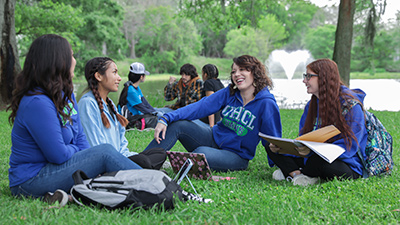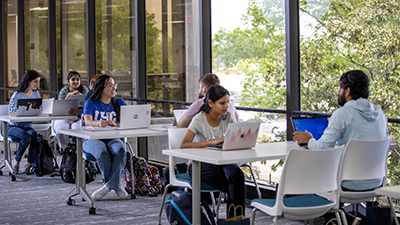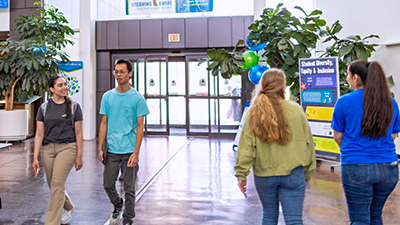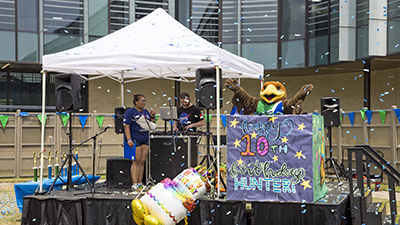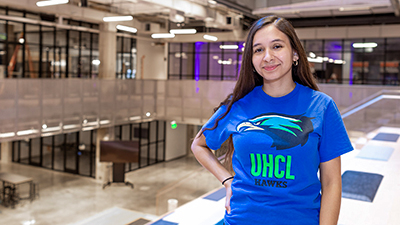
Aerospace Seminar Series
12-Week Seminar Series
Every Thursday: September 4 - November 20
Time: 4-5 p.m.
Location: STEM Building, Room 1203
About
Brought to you by UHCL College of Science & Engineering in partnership with Aeroscience and Flight Mechanics Division at NASA Johnson Space Center. This weekly series showcases practical applications of aerospace engineering, taught by subject-matter experts from NASA JSC.
Schedule
September 4, 2025
An Introduction to Guidance, Navigation, and Control
Speakers:
- Siddarth Kaki, Ph.D. – Navigation Discipline Engineer, EG6 / GN&C Autonomous Flight Systems Branch, NASA Johnson Space Center
- Jacob Sullivan – EG6 / GN&C Autonomous Flight Systems Branch, NASA Johnson Space Center
September 11, 2025
Radionavigation
Speaker:
- Dr. Greg Holt - GN&C Autonomous Flight Systems Branch, NASA Johnson Space Center
Speaker Bio:
Dr. Greg Holt is the Navigation Technical Discipline lead and System Manager for the
Orion Multi-Purpose Crew Vehicle at NASA Johnson Space Center, having earned a Ph.D.
from the University of Texas at Austin and with over 15 years of NASA service. He
has enjoyed many opportunities to be active in technical leadership and is a veteran
Mission Control navigator of 8 Space Shuttle missions, the Orion Exploration Flight
Test 1, and the Artemis I lunar mission.
Abstract:
Explore the principles and evolution of RadioNavigation, a cornerstone of modern aerospace
engineering. We’ll trace the historical progression from early celestial navigation
to advanced systems like the Global Positioning System (GPS), Global Navigation Satellite
Systems (GNSS), NASA’s Deep Space Network (DSN), and emerging lunar relay satellite
architectures for Artemis missions. Through technical insights, practical examples,
and discussions of triangulation, signal processing, and deep-space communication
challenges, this talk will illuminate the critical role of radio navigation in enabling
precise positioning for terrestrial and extraterrestrial exploration.
September 18, 2025
Entry, Descent, and Landing
Speaker:
- Dr. Sergio Sandoval - Guidance Engineer, NASA Johnson Space Center
Speaker Bio:
Sergio Sandoval is a guidance engineer at NASA’s Johnson Space Center. He received
a bachelor’s degree in Aerospace Engineering at the Georgia Institute of Technology
in December 2017. During his undergraduate studies, he collaborated with the Space
Systems Design Lab as part of Prox-1, the first satellite ever made by Georgia Tech
students and with the Aerospace Systems Design Lab doing Systems Engineering for NASA
projects such as the Europa Clipper and the TransHab Structure. His participation
in these projects led to a Pathways Internship offer at the Johnson Space Center starting
in August 2016, and an internship with the Jet Propulsion Lab during the summer of
2016. He completed his PhD in Aerospace Engineering at San Diego State University
and the University of California San Diego in 2023. During his time at NASA, he has
held different positions such as Systems Engineer for the Europa Clipper mission,
Trajectory Operations and Planning Engineer for the International Space Station, Structural
Engineer for experiments going to the International Space Station, and more recently
he started as a Guidance Engineer for human and robotic exploration missions to the
Moon, Mars, and beyond. He currently applies his expertise of Entry, Descent, and
Landing to support the Orion Re-entry analysis for the Artemis Program.
Abstract:
Safety, precision, and efficiency are the key ingredients for successful human-scale
entry, descent, and landing (EDL) in missions to the Moon, Mars and beyond. As one
of the most dynamic and challenging phases of any interplanetary mission, it is very
important to understand the different techniques, the conditions in which we apply
these techniques, and for what reason. In this seminar, we will explore a complete
overview of entry and powered descent guidance, from its origin to the state of the
art. We will investigate successful examples that have flown to space before, as well
as dive into the requirements of a mission in the future.
September 25, 2025
Optical Navigation
Speaker:
- Dr. Paul McKee
Speaker Bio:
Paul McKee was born and raised in Averill Park, NY. He studied mechanical and aerospace
engineering at Rensselaer Polytechnic Institute (RPI), getting his B.S. in 2017, his
M.S. in 2018, and his Ph.D. in 2022. His research was on autonomous spacecraft navigation.
He now works at NASA Johnson Space Center in the Aeroscience and Flight Mechanics
Division. His projects include Optical Navigation hardware and software analysis for
the Orion spacecraft, lunar surface navigation algorithm development for the Artemis
program, and he is Assistant to the Project Manager for Project TRON -- a next-gen
optical navigation early-career project. Paul is also involved in numerous outreach
efforts to grade school STEM students, and is a (remote) adjunct professor at RPI,
teaching a graduate-level course in spacecraft navigation.
Abstract:
A spacecraft can determine its position and attitude (orientation) using information
in digital images taken with an onboard camera. This is referred to as Optical Navigation
(OpNav). This begins with an understanding of cameras as navigation instruments, and
how useful data can be extracted from images. Well-established methods of OpNav for
attitude determination and localization are discussed, and then time is spent on some
of the newer and more exotic problems in OpNav. Audience participation is highly encouraged
and imagination will be a requirement.
October 2, 2025
Spacecraft Controls
Speaker:
- Dr. Omkar Mulekar
Speaker Bio:
Omkar Mulekar joined NASA Johnson Space Center in July 2024 as a navigation analyst
for the Orion Relative Navigation system and as a controls engineer for the Gateway
Controls system. He holds a PhD and a master’s degree from the University of Florida
as well as a bachelor’s degree from Auburn University. His graduate research includes
the use of neural networks to perform feedback-optimal control of nonlinear systems.
Abstract:
In this presentation, we will discuss the “Control” element of a spacecraft’s Guidance,
Navigation, and Control system. From its overarching purpose on a spacecraft to specific
examples of how we apply control logic to command actuators onboard autonomous spacecraft,
we will explore the modern challenges of maintaining control in complex, harsh environments.
October 9, 2025
How Do You Throw a Refrigerator Away in Space – The story about jettisoning a large piece of equipment from the ISS without killing anyone in a illustration of what rocket science is all about.
Speaker:
- Dr. Robert Dempsey, aka “Dr. Bob”
Speaker Bio:
Dr. Robert Dempsey, aka “Dr. Bob”, received his PhD in astrophysics from the University
of Toledo in 1984. He worked on the Hubble Space Telescope for 5 years, both as an
operator and a researcher. In his astronomy career, he published over 30 peer-reviewed
articles. After programming his job away, and because he wanted to get involved in
human space exploration, Dr. Bob literally got on a plane and cold-called United Space
Alliance in Houston. He joined the ISS program in 1997 as a Command & Data Handling
front room controller (“ODIN”) due to said programming skills, before transitioning
to Communications & Tracking (“CATO”) in 2003. After supporting numerous International
Space Station assembly missions, in 2005, he was selected as a Flight Director (call
sign “Galileo”). Over his 17+ years as Flight, he led numerous Shuttle assembly missions,
crewed and uncrewed dockings/undockings, and spacewalks, including one where the Russians
removed a live pyro bolt from the Soyuz. He helped lead the NASA Mission Operations
team that operated Boeing’s Starliner spacecraft, including on the ill-fated Orbital
Flight Test in 2019. In 2022, he retired from the ISS program office and joined Blue
Origin. While at Blue Origin, he has led mission operations for the Orbital Reef,
the crewed space vehicle, and the New Shepard suborbital program, while also contributing
to the New Glenn project. Since July, he has been working part-time at Blue Origin
while also working on a book about the Commercial Crew Program, a novel about time
travel, and consulting when not baking bread or cookies.
October 16, 2025
Machine Learning and Artificial Intelligence for Space Applications
Speaker:
- Dr. Julia Briden
Speaker Bio:
Julia Briden works as an Advanced Mission Design and GN&C Engineer at NASA Johnson
Space Center on the Amentum JETS-II Contract. She has received her PhD in Aeronautics
and Astronautics, with a major in Autonomy, from MIT in 2024 and her Master’s and
Bachelor’s, with a minor in Artificial Intelligence, from the Illinois Institute of
Technology in 2021. Her research focuses on using deep learning for efficient spacecraft
guidance.
Abstract:
This talk introduces the field of artificial intelligence (AI) and its sub-field,
machine learning (ML), through the lens of space exploration. We begin by outlining
the major categories of AI and ML and how they enable perception, reasoning, and decision-making
in autonomous systems. The discussion then distinguishes between offline applications,
where AI supports mission design and planning on the ground, and onboard implementations,
where algorithms must operate in real time under strict computational and reliability
constraints. The talk concludes with an overview of current research advancing ML
for online guidance and control, highlighting efforts to improve efficiency, adaptability,
and trustworthiness in future autonomous spacecraft.
October 23, 2025
Spacecraft Trajectory & Mission Design
Speaker:
- Dr. Stephen Scheuerle
Speaker Bio:
Stephen Scheuerle is a mission design engineer for NASA’s Gateway Program. He received
his M.S. and Ph.D. in Aeronautical and Astronautical Engineering from Purdue University,
and his B.S. in aerospace engineering from NC State University in 2018. Stephen’s
graduate research focused on spacecraft trajectory design in multi-body systems, specifically
exploring propellant efficient pathways for spacecraft in the three-body and four-body
problems.
Abstract:
This talk introduces orbital mechanics, and the role it plays in spaceflight. The
presentation discusses the history of trajectory design, sharing the discoveries astronomers
and mathematicians that shape modern-day trajectory design. The presentation then
covers an overview of the types of trajectories spacecraft follow, and what it means
to work in trajectory design. Finally, the presentation will focus on the role trajectory
design and orbital mechanics play in end-to-end mission design. Looking at how constraints
and objectives drive mission planning.
October 30, 2025
Essential Communication Skills in Engineering – Bill Tindall and the Apollo Program
Speaker:
- Dr. John Goodman
Abstract:
Bill Tindall is credited by many who worked in the Gemini and Apollo Programs with
playing a key role in leading the development of flight techniques used to design
and fly the Gemini and Apollo missions. Tindall had a talent for bringing order to
complex projects and was a master at guiding emotional and contentious technical discussions
in meetings toward a decision. Tindall communicated technical issues in a simple and
understandable manner to personnel representing a variety of technical disciplines,
including engineers, program managers, astronauts, scientists, and computer programmers.
His Gemini and Apollo era memos, called "Tindallgrams," are treasured by many space
program veterans. Tindall’s success was due to his mastery of essential communication
skills. University courses in engineering and the humanities help engineering students
develop these skills.
Speaker Bio:
John Goodman has worked as a contractor at the NASA Johnson Space Center for almost
40 years, supporting both the Mission Operations and Engineering Directorates. His
experience includes the Space Shuttle, X-38, International Space Station, Constellation,
and Artemis Programs, as well as three commercial space vehicles. The topics of his
internal and external publications include lessons learned, orbital rendezvous techniques,
powered flight guidance development, knowledge management, and contributions of key
engineers to the Apollo and Space Shuttle Programs.
November 6, 2025
Artemis, Orion, and Coming Home from the Moon
Speaker:
- Dr. Justin Cooper
Abstract:
We'll discuss the Artemis mission, the Orion Crew Module (CM), and special considerations
to Aerothermodynamics including how the trajectory affects the physics of heating
and the components that make the heating environment complex. We’ll also take a special
look at the Artemis-I post flight analysis of the heat shield and look at unique cabin
footage demonstrating what a re-entry looks like from the perspective of the astronaut
(it's kind of scary). Outside of entry physics, we’ll also briefly touch on the heat
shield material itself and what makes it uniquely capable to protect the crew from
severe heating environments.
Speaker Bio:
Dr. Justin Martyn Cooper joined the US Army directly out of high school and served
in the special Infantry Unit Long Range Surveillance Detachment (LRSD) in the years
directly following 9/11. Back in Kentucky, he spent time as a locksmith and spent
several years in college including majoring in synthetic organic chemistry. But o-chem
didn’t scratch the itch, so he spent time in Marina Del Rey, California working as
a background actor and living on a sailboat that frequently meandered up and down
the western coast. Upon returning to Kentucky from west coast life, he acquired all
of the degrees you can obtain in mechanical engineering, including a Ph.D. in uncoupled
engineering methodologies for hypersonic fluid solvers and thermal response systems.
He currently works in the Aerosciences and CFD branch at NASA JSC as an Aerothermodynamicist
and has recently been involved in testing and installation of the Orion Heatshield
Spectrometer project at KSC, as well as helping to develop the special models that
govern the heating predictions for the AR2 heat shield (cavity heating models).
Leading to Win in Life and Work
Speaker:
- Dr. Josh O'Neal, Senior Staff, Lockheed Martin
Speaker Bio:
Dr. Josh O'Neal brings together a rare blend of academic excellence and real-world
leadership, holding a PhD in Materials Science & Engineering from Texas A&M and serving
as a member of the Senior Staff at Lockheed Martin. With over a decade of experience
driving high-impact initiatives, he has guided teams and mentored both students and
emerging professionals to grow beyond their limitations. As a speaker, Josh is passionate
about equipping the next generation of leaders with the tools, mindset, and vision
to lead with clarity and purpose. His message reflects the belief that true influence
is not measured by titles, but by the lives we inspire and the leaders we multiply.
Abstract:
Your success or failure in life and work comes down to one thing: leadership. The
difference-maker in your personal and professional relationships is your ability to
influence those around you. This is done through your attitude and your actions, but
it all starts with YOU. How you lead yourself will determine the level of your success
in any endeavor. In this talk, Dr. O'Neal will equip you with a simple, effective
approach to achieve victory in any area of your life using foundational, actionable
principles to help you break the inertia of complacency and bring discipline to bear
on any challenge you face.
November 13, 2025
NASA's HyperSTEP Entry Test Platform
Speaker:
- Breanna Johnson
Speaker Bio:
Breanna Johnson leads the HyperSTEP project at NASA's Johnson Space Center. She graduated
from the University of Michigan with a B.S.E. in Aerospace Engineering and Georgia
Institute of Technology with a M.S. in Computer Science. Breanna has provided Guidance,
Navigation, and Control support across a number of different projects and vehicles
including Orion, Mars Sample Return, human Mars concept vehicles, Ice Giants Aerocapture,
SPLICE, and Pterodactyl.
Abstract:
NASA is lowering the barrier to entry for both general hypersonic and entry, descent,
and landing (EDL) technologies with the development of a low-cost, recoverable, scalable,
rapidly developed test platform. The Hypersonic Testing for Entry Platform, HyperSTEP,
enables the low-cost flight demonstration of technologies by leveraging a publishable
government reference lifting body vehicle design. Industry, academia, and other government
agencies are able to partner with HyperSTEP for future opportunities.
November 20, 2025
Progress and Challenges of Spacecraft Autonomous Navigation
Speaker:
- Dr. Christopher D’Souza
Speaker Bio:
Dr. Chris D'Souza has served as the NASA GNC Technical Fellow since 2023. Prior to
that, he was the Absolute Navigation Technical Discipline Lead for Human Spaceflight
at the Johnson Space Center. He has been at NASA since 2005. Prior to that he was
at the Charles Stark Draper Laboratory developing guidance laws and navigation algorithms
(in Cambridge and Houston). He was employed by the US Air Force Research Laboratory
from 1991-1996 working on advanced optimization techniques and optimal guidance laws.
He worked at the Jet Propulsion Lab from 1984-1990 on the Magellan and Galileo missions.
His research interests are optimal guidance laws, onboard estimation, nonlinear estimation,
covariance analysis, and trajectory optimization and targeting.
Longer bio: https://www.nasa.gov/people/dr-christopher-n-dsouza/
Abstract:
With the advent of a new chapter of space exploration, there is an ever-increasing
need for autonomous navigation for spacecraft. Whereas GPS is used almost exclusively
for spacecraft in Earth orbit, future generations of spacecraft which will operate
outside of the GPS shell will need to navigate without an entrenched navigation infrastructure.
New methods of navigation are already being developed and matured to allow spacecraft
to autonomously operate far from Earth. Most of these are vision-based, although
several are pushing the envelope on radiometric measurements. This talk will address
the current state of the art and the challenges in navigation and filtering in cislunar
and interplanetary exploration.
Contact
Dr. Youssef Hamidi, Associate Professor of Mechanical Engineering
281-283-3818
hamidi@uhcl.edu
STEM 2232
